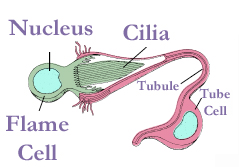Flame cell
Specialized excretory cell in flatworms
A flame cell is a specialized excretory cell found in the simplest invertebrates, including flatworms such as planarians, tapeworms, and flukes. Flame cells function like a kidney, removing waste materials. Bundles of flame cells are called protonephridia.
Structure[edit | edit source]
Flame cells are so named because the beating of the cilia within the cell resembles a flickering flame. Each flame cell consists of a hollow cell containing a tuft of rapidly beating cilia. The cilia project into a tubule that leads to the outside of the organism. The movement of the cilia draws waste fluids through a network of tubules and out of the body.
Function[edit | edit source]
Flame cells are primarily involved in the excretion of waste products and the regulation of osmotic balance. They filter and remove excess water and waste products from the body fluids of the organism. The waste is then expelled through a series of tubules that open to the exterior of the organism.
Location[edit | edit source]
Flame cells are distributed throughout the body of the organism, often in a network that spans the entire length of the body. This network is known as the protonephridial system.
Mechanism[edit | edit source]
The mechanism of waste removal in flame cells involves the beating of cilia, which creates a current that draws waste fluids into the tubule system. The waste is then transported through the tubules and expelled from the body. This process is essential for maintaining the organism's internal environment and preventing the accumulation of toxic substances.
Significance[edit | edit source]
Flame cells are an important adaptation for flatworms, allowing them to live in a variety of aquatic and terrestrial environments. By efficiently removing waste and regulating osmotic balance, flame cells help these organisms maintain homeostasis.
Related pages[edit | edit source]
Search WikiMD
Ad.Tired of being Overweight? Try W8MD's physician weight loss program.
Semaglutide (Ozempic / Wegovy and Tirzepatide (Mounjaro / Zepbound) available.
Advertise on WikiMD
|
WikiMD's Wellness Encyclopedia |
| Let Food Be Thy Medicine Medicine Thy Food - Hippocrates |
Translate this page: - East Asian
中文,
日本,
한국어,
South Asian
हिन्दी,
தமிழ்,
తెలుగు,
Urdu,
ಕನ್ನಡ,
Southeast Asian
Indonesian,
Vietnamese,
Thai,
မြန်မာဘာသာ,
বাংলা
European
español,
Deutsch,
français,
Greek,
português do Brasil,
polski,
română,
русский,
Nederlands,
norsk,
svenska,
suomi,
Italian
Middle Eastern & African
عربى,
Turkish,
Persian,
Hebrew,
Afrikaans,
isiZulu,
Kiswahili,
Other
Bulgarian,
Hungarian,
Czech,
Swedish,
മലയാളം,
मराठी,
ਪੰਜਾਬੀ,
ગુજરાતી,
Portuguese,
Ukrainian
Medical Disclaimer: WikiMD is not a substitute for professional medical advice. The information on WikiMD is provided as an information resource only, may be incorrect, outdated or misleading, and is not to be used or relied on for any diagnostic or treatment purposes. Please consult your health care provider before making any healthcare decisions or for guidance about a specific medical condition. WikiMD expressly disclaims responsibility, and shall have no liability, for any damages, loss, injury, or liability whatsoever suffered as a result of your reliance on the information contained in this site. By visiting this site you agree to the foregoing terms and conditions, which may from time to time be changed or supplemented by WikiMD. If you do not agree to the foregoing terms and conditions, you should not enter or use this site. See full disclaimer.
Credits:Most images are courtesy of Wikimedia commons, and templates, categories Wikipedia, licensed under CC BY SA or similar.
Contributors: Prab R. Tumpati, MD

